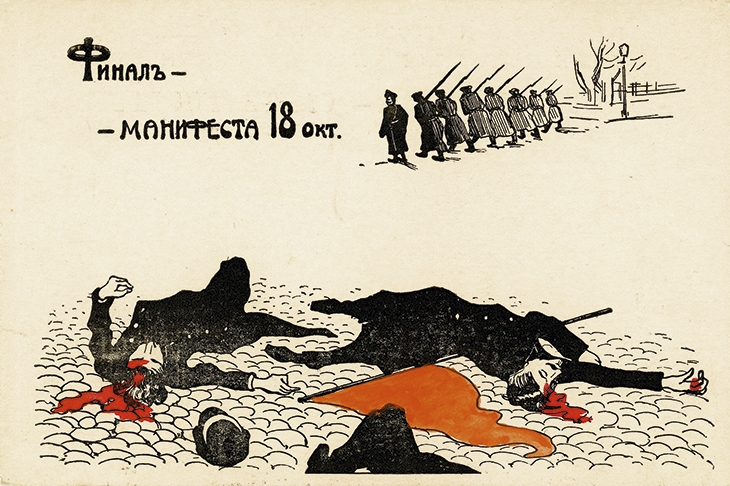In this handsomely illustrated book Tobie Mathew makes a case for the lowly postcard’s role in the politicisation of pre-revolutionary Russia. Cheap to produce, easily transported and hidden, and conveying a simple graphic message, picture postcards were ideally suited to anti-government agitation. Too dangerous to post, these little shots of sedition were preserved and shared for years in the postcard albums that were a feature of any polite drawing-room and increasing numbers of peasant huts and workers’ barracks.
Before 1905 revolutionary groups printed postcards abroad and smuggled them into the country, simultaneously spreading their message and raising funds. The Russo-Japanese war provided good material for satirical images, yet in those days the number of active revolutionaries was minute —perhaps a few thousand in a country of 125 million — and the vast majority of Russians were unthinkingly loyal.
When Cossacks opened fire on a huge peaceful demonstration in St Petersburg on 9 January 1905, however, it transformed the political landscape in Russia for ever. The events of Bloody Sunday swiftly spread throughout the empire, sparking a year of uprisings and strikes. Postcards showing the massacre appeared immediately and remained a staple of anti-government propaganda. In the chaos of the following months dissidents were able to print cards within Russia and distribute them more freely. Even commercial publishers found there was such a demand for anti-Tsarist images that they began to produce their own, often identical to those of the revolutionaries.

By the autumn, Nicholas II finally agreed to offer some concessions. The October Manifesto granted considerable freedoms of speech and of the press; censorship was handed over to the courts, a lengthy business which meant items could be circulating for months before they were recalled. A veritable ‘bacchanalia of publishing’ ensued, with 93 new companies opening by April 1906 and a flood of satirical images sweeping through the empire. For half a century radicals in Russia had been complaining that ‘theoretical ideas bounced off the Russian masses like peas off a wall’. Now a moment of brief political liberalism combined with a burgeoning consumer society to penetrate even the remotest areas. Capitalism turned out to be a more effective means of spreading Marxist propaganda than any the revolutionary parties had imagined; suddenly the Bolsheviks found themselves trotting around from bookshop to bookshop with briefcases full of wares, like conventional salesmen.
But the state was soon clawing back control, closing down publishing houses and making arrests. By 1907 the legal publication of dissident images was banned. The revolutionary movement began to disintegrate within Russia and the experimental representative government was stripped of its powers. Harsh reprisals against the uprisings, which resulted in thousands being executed, brought an uneasy peace to the country. Yet it’s fascinating to imagine these postcards within the homes of millions of Russians during the following decade, subversive thoughts just waiting to be put into practice.
Like every publication that I’ve seen from Four Corners Books (including the irresistible UFO Drawings from the National Archive, a favourite birthday present this year), Greetings from the Barricades looks a treat. The illustrations are vivid and copious and the layout is stylish. If the text is a little too detailed for the casual reader, the book still promises happy times for anyone with an interest in early 20th-century Russian art and history.






Comments